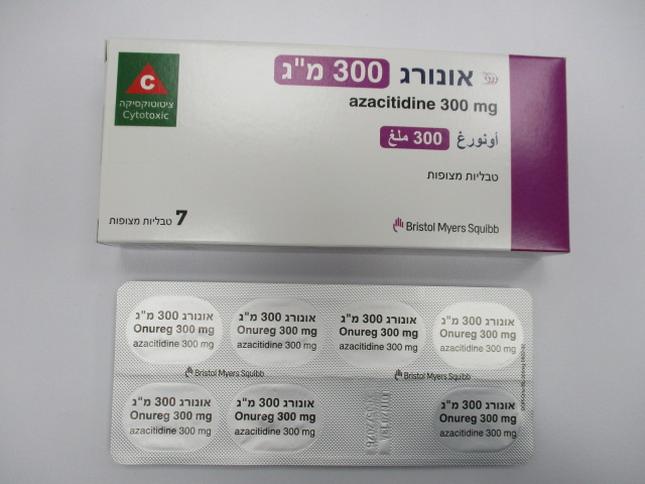Quest for the right Drug

אונורג 300 מ"ג ONUREG 300 MG (AZACITIDINE)
תרופה במרשם
תרופה בסל
נרקוטיקה
ציטוטוקסיקה
צורת מתן:
פומי : PER OS
צורת מינון:
טבליות מצופות פילם : FILM COATED TABLETS
עלון לרופא
מינוניםPosology התוויות
Indications תופעות לוואי
Adverse reactions התוויות נגד
Contraindications אינטראקציות
Interactions מינון יתר
Overdose הריון/הנקה
Pregnancy & Lactation אוכלוסיות מיוחדות
Special populations תכונות פרמקולוגיות
Pharmacological properties מידע רוקחי
Pharmaceutical particulars אזהרת שימוש
Special Warning עלון לרופא
Physicians Leaflet
Adverse reactions : תופעות לוואי
4.8 Undesirable effects Summary of the safety profile The most common adverse reactions are nausea (64.8%), vomiting (59.7%), diarrhoea (50.4%), neutropenia (44.5%), fatigue/asthenia (44.1%)5, constipation (38.6%), thrombocytopenia (33.5%), abdominal pain (21.6%)4, respiratory tract infection (17%)2, arthralgia (13.6%), decreased appetite (12.7%), febrile neutropenia (11.9%), back pain (11.9%), leucopenia (10.6%), pain in extremity (10.6%) and pneumonia (10.2%)1. Onureg_API_June2022_clean Serious adverse reactions occurred in 16.1% of patients receiving Onureg. The most common serious adverse reactions are febrile neutropenia (6.8%) and pneumonia (5.1%)1. Permanent discontinuation of Onureg due to an adverse reaction occurred in 6.8% of patients. The most common adverse reactions requiring permanent discontinuation are nausea (2.1%), diarrhoea (1.7%), and vomiting (1.3%). Dose interruptions due to an adverse reaction occurred in 36.4% of patients who received Onureg. Adverse reactions requiring dose interruption include neutropenia (19.9%), thrombocytopenia (8.5%), nausea (5.5%), diarrhoea (4.2%), vomiting (3.8%), pneumonia (3.4%)1, leucopenia (2.5%), febrile neutropenia (2.1%), and abdominal pain (2.1%)4. Dose reductions due to an adverse reaction period occurred in 14% of patients who received Onureg. Adverse reactions requiring dose reduction included neutropenia (5.5%), diarrhoea (3.4%), thrombocytopenia (1.7%), and nausea (1.7%). Tabulated list of adverse reactions Table 2 presents the frequency category of ADRs reported in the pivotal Phase 3 study with Onureg. A total of 236 patients received Onureg. The median treatment duration was 11.6 months (range: 0.5 to 74.3 months) for Onureg arm. Frequencies are defined as: very common (≥ 1/10); common (≥ 1/100 to < 1/10); uncommon (≥ 1/1,000 to < 1/100); rare (≥ 1/10,000 to < 1/1,000); very rare (< 1/10,000); not known (cannot be estimated from the available data). Within each frequency grouping, undesirable effects are presented in order of decreasing seriousness. Adverse reactions are presented in the table below according to the highest frequency observed. Onureg_API_June2022_clean Table 2: Adverse drug reactions (ADRs) in AML patients receiving Onureg maintenance therapy System organ class All gradesa frequency Infections and infestations Very common Pneumonia1, 6, respiratory tract infection2 Common Influenza, urinary tract infection3, bronchitis, rhinitis Blood and lymphatic system Very common disorders Neutropenia, thrombocytopenia6, febrile neutropenia6, leucopenia Metabolism and nutrition disorders Very common Decreased appetite Psychiatric disorders Common Anxiety Gastrointestinal disorders Very common Nausea, vomiting, diarrhoea, constipation, abdominal pain4 Musculoskeletal and connective tissue Very common disorders Arthralgia, back pain, pain in extremity General disorders and administration Very common site conditions Fatigue / asthenia5 Investigations Common Weight decreased a AllAEs with at least 5.0% of patients in the Onureg arm and at least 2.0% higher frequency than the placebo arm. 1 Grouped terms include pneumonia, bronchopulmonary aspergillosis, lung infection, Pneumocystis jirovecii pneumonia, atypical pneumonia, pneumonia bacterial, and pneumonia fungal. 2 Grouped terms include upper respiratory tract infection, respiratory tract infection, and respiratory tract infection viral. 3 Grouped terms include urinary tract infection, urinary tract infection bacterial, Escherichia urinary tract infection, and cystitis. 4 Grouped terms include abdominal pain, abdominal pain upper, abdominal discomfort, and gastrointestinal pain. 5 Grouped terms include fatigue and asthenia. 6 Adverse reactions in which at least one was considered to be life threatening (if the outcome of the reaction was death, it is included with death cases). Description of selected adverse reactions Haematological toxicity New or worsening Grade 3 or higher neutropenia (41.1%), thrombocytopenia (22.5%), or febrile neutropenia (11.4%) were commonly reported adverse reactions in patients treated with Onureg. The first occurrence of Grade 3 or 4 neutropenia, thrombocytopenia, or febrile neutropenia occurred within the first 2 cycles in 19.9%, 10.6%, and 1.7%, respectively in patients treated with Onureg. See section 4.2 for monitoring and management guidance. Gastrointestinal toxicity Gastrointestinal toxicities were the most frequent adverse reactions in patients treated with Onureg. Nausea (64.8%), vomiting (59.7%), and diarrhoea (50.4%) were reported in patients treated with Onureg. Grade 3 or higher diarrhoea occurred in 5.1% of patients and Grade 3 or higher vomiting and nausea occurred in 3.0% and 2.5%, respectively in patients treated with Onureg. The first occurrence of Grade 3 or 4 nausea, vomiting, or diarrhoea occurred within the first 2 cycles in 1.7%, 3.0%, and 1.3%, respectively, in patients treated with Onureg. See section 4.2 for monitoring and management guidance. Reporting of suspected adverse reactions Reporting suspected adverse reactions after authorisation of the medicinal product is important. It allows continued monitoring of the benefit/risk balance of the medicinal product. Any suspected adverse event should be reported to the Ministry of Health according to the National Regulation by using an online form https://sideeffects.health.gov.il/. Onureg_API_June2022_clean

פרטי מסגרת הכללה בסל
א. הטיפול בתרופה יינתן לטיפול מתמשך בלוקמיה מסוג AML בחולים שהשיגו תגובה מלאה או תגובה מלאה עם החלמה לא מלאה של ספירות הדם (incomplete blood count recovery (CRi)) לאחר אינדוקציה כימותרפית אינטנסיבית, שאינם מסוגלים לקבל טיפול קוראטיבי אינטנסיבי. במחלה מסוג AML עם מוטציה מסוג FLT3, במהלך מחלתו יוכל החולה לקבל תרופה אחת מבין השתיים כטיפול אחזקה – Azacitidine, Midostaurinב. מתן התרופה ייעשה לפי מרשם של מומחה באונקולוגיה או רופא מומחה בהמטולוגיה.
שימוש לפי פנקס קופ''ח כללית 1994
לא צוין
תאריך הכללה מקורי בסל
03/02/2022
הגבלות
תרופה מוגבלת לרישום ע'י רופא מומחה או הגבלה אחרת
רישום
169 94 36930 99
מחיר
0 ₪
מידע נוסף
